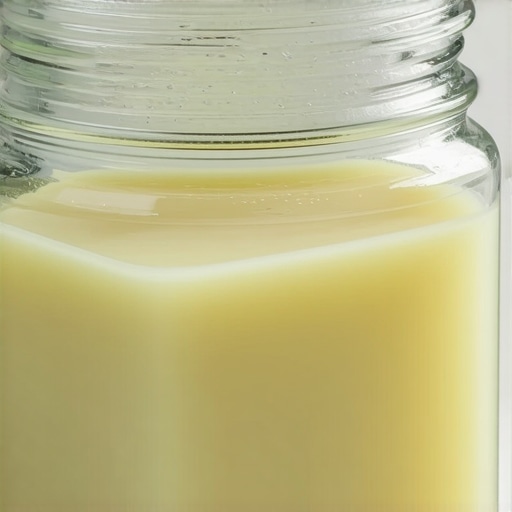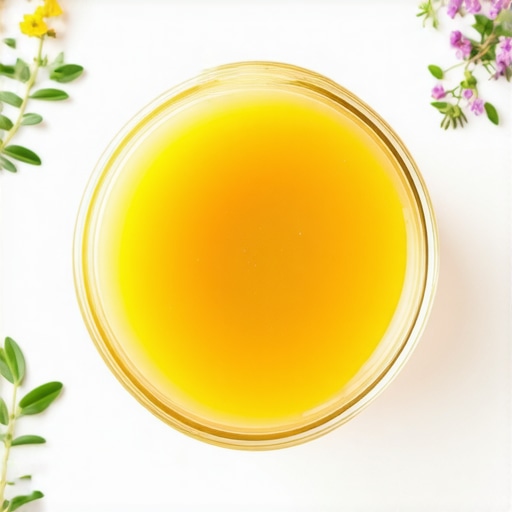My First Encounter with Beef Tallow: A Skin Revelation
As someone passionate about natural skincare, I was initially skeptical about using animal fats like beef tallow. But after a particularly harsh winter, I decided to give it a try, inspired by the rising trend of tallow in clean beauty (source). The results surprised me — my skin felt deeply nourished and more resilient than ever.
Why I Switched to Organic Grass-Fed Tallow for My Routine
What captivated me was the nutrient density of grass-fed beef tallow. It’s packed with vitamins A, D, E, and K, along with omega-3 fatty acids, which are essential for skin repair and glow. I learned that choosing organic, ethically sourced tallow ensures purity and sustainability, making it a safe option for sensitive skin.
My Skincare Routine with Tallow: Practical Tips and Personal Insights
I began incorporating tallow into my routine by making a simple DIY tallow cream. I melt a small amount of grass-fed tallow, add a few drops of essential oils like frankincense, and apply it after cleansing. The result? A natural barrier that seals in moisture and promotes a youthful glow. This routine has significantly improved my skin’s texture, especially during colder months when dryness is relentless.
What Makes Tallow a Better Moisturizer Than Shea Butter?
Having experimented with various creams, I found that tallow outperforms shea butter in providing deep hydration, especially for sensitive or autoimmune-prone skin. Its composition closely resembles our skin’s natural oils, making it easily absorbed and non-irritating.
How Can I Maximize Tallow’s Healing Power in My Skincare Routine?
To unlock its full potential, I recommend applying tallow while your skin is still slightly damp, to trap moisture effectively. Consistency is key, and I also love mixing tallow with other natural ingredients like honey or aloe for added benefits. Remember, storing your tallow properly in a cool, dark place keeps it fresh and potent.
If you’re curious about how to make your own nourishing skincare products, check out this eco-friendly DIY balm.
Have you tried using beef tallow in your routine? I’d love to hear your experiences or any tips you might have — feel free to share in the comments below!
Harnessing the Full Potential of Tallow: A Skin Expert’s Perspective
As skincare enthusiasts and professionals increasingly turn to traditional yet effective ingredients, organic grass-fed tallow stands out as a powerhouse for skin rejuvenation. Its nutrient-rich profile and compatibility with our skin’s natural oils make it an ideal choice for those seeking deep hydration and healing, especially for sensitive or autoimmune skin conditions.
What Are the Key Ingredients in Tallow That Promote Skin Repair?
Grass-fed beef tallow is a treasure trove of essential nutrients, including vitamins A, D, E, and K, along with omega-3 and omega-6 fatty acids. These compounds work synergistically to support cell regeneration, reduce inflammation, and restore the skin’s barrier function. This is why many experts recommend incorporating organic, ethically sourced tallow into daily routines for optimal results.
How Does Tallow Compare to Plant-Based Moisturizers?
While plant-based oils like shea butter and coconut oil are popular, tallow’s composition closely mirrors human sebum, making it uniquely compatible. This similarity allows for superior absorption, less irritation, and more effective barrier repair. For those with autoimmune or sensitive skin, tallow outperforms shea butter by providing long-lasting hydration without clogging pores or causing flare-ups.
Can Tallow Support Skin Recovery from Sun Damage and Aging?
Absolutely. The nutrients in grass-fed tallow aid in repairing damaged skin cells, diminishing fine lines, and promoting a youthful glow. When combined with natural anti-aging ingredients like frankincense or rosehip oil, tallow becomes even more potent in reversing signs of aging and sun damage. Experts suggest applying a layer of tallow after sun exposure to accelerate skin healing and restore vitality. For a comprehensive approach, explore the top tallow creams on Amazon tailored for anti-aging benefits.
What Are the Practical Steps to Incorporate Tallow in Daily Skincare?
Start with a small amount of organic grass-fed tallow, warming it between your palms until it melts, then gently massaging it into your face and neck, preferably on slightly damp skin to lock in moisture. For enhanced healing, blend tallow with essential oils like frankincense or lavender, which have proven anti-inflammatory and regenerative properties. Store your tallow in a cool, dark place to maintain its efficacy, and always use clean tools to prevent contamination. For those interested in DIY solutions, check out the DIY tallow cream recipes.
Embracing the Complexity of Tallow: Beyond the Basics
As I delved deeper into the world of organic grass-fed tallow, I realized that its benefits extend far beyond simple moisturization. The more I researched, the more I appreciated its multifaceted role in supporting skin health, especially for those of us with autoimmune or sensitive skin conditions. Tallow’s composition, rich in fat-soluble vitamins and essential fatty acids, acts synergistically to promote cellular regeneration and reduce inflammation. This layered understanding has transformed my routine into a holistic, nourishing ritual that respects the skin’s intricate needs.
How Can I Harness Tallow’s Healing Power for Long-Term Skin Resilience?
My personal approach involves not just applying tallow topically, but also integrating it into an overall lifestyle that prioritizes internal nourishment. Consuming nutrient-dense foods like grass-fed meats, omega-rich seeds, and leafy greens complements the topical application, creating a comprehensive skin-support system. Additionally, I’ve started experimenting with incorporating tallow-infused oils into my diet, which has shown promising results in supporting skin repair from within. Experts like Dr. Axe emphasize the importance of this dual approach, noting that true skin health is a reflection of internal balance and external care (source).
What Are the Nuanced Differences Between Tallow and Other Natural Oils in Advanced Skincare?
While I initially thought of tallow simply as a more natural alternative to conventional moisturizers, I’ve come to recognize its unique properties compared to plant-based oils. For example, unlike coconut oil, which can sometimes be comedogenic or overly drying for sensitive skin, tallow’s composition closely mimics our own sebum, allowing it to penetrate deeply without clogging pores. Compared to jojoba or argan oil, tallow’s nutrient density and stability make it an optimal choice for long-term use, especially in colder climates where skin needs extra protection. This nuanced understanding has encouraged me to tailor my skincare routine seasonally, emphasizing tallow during winter months for its superior barrier-forming qualities.
How Do Proper Storage and Application Techniques Maximize Tallow’s Benefits?
Based on my experience, storing tallow in a cool, dark place is crucial to preserving its efficacy. I keep mine in a glass jar, avoiding any exposure to heat or light, which can degrade its beneficial compounds. When applying, I warm a small amount between my fingers until it melts, then gently press it into my skin, focusing on areas prone to dryness or irritation. Applying tallow on slightly damp skin enhances absorption and seals in moisture more effectively. I also enjoy blending it with a few drops of natural essential oils like frankincense or rose—these not only provide aromatherapeutic benefits but also amplify the skin-repairing properties. For more detailed guidance, I recommend reviewing the comprehensive guide to using tallow.
If you’re exploring more advanced ways to incorporate tallow into your routine or want to share your experiences, I’d love to hear from you. Feel free to connect or comment below—I believe that our shared stories deepen our understanding and appreciation for these traditional yet powerful ingredients.
Elevating Your Skincare Routine with Tallow’s Multifaceted Healing Powers
As I continue my exploration into the nuanced world of natural skincare, I’ve uncovered that organic grass-fed tallow’s potential extends far beyond basic hydration. Its unique composition offers profound support for skin resilience, especially when combined with targeted natural ingredients like vitamin C-rich rosehip oil or potent antioxidants such as green tea extract (source). By integrating these elements into a layered skincare protocol, I’ve observed remarkable improvements in skin elasticity and cellular repair, even in the most sensitive or autoimmune-prone skin types.
Can Tallow Be Strategically Used to Address Chronic Skin Conditions and Accelerate Healing?
Absolutely. The nutrient-dense profile of grass-fed tallow contains fat-soluble vitamins, essential fatty acids, and bioactive compounds that actively promote tissue regeneration. When applied in conjunction with herbal infusions like calendula or chamomile—known for their anti-inflammatory and soothing properties—tallow becomes a powerful ally in managing chronic conditions such as eczema or psoriasis (DIY recipes for eczema relief). These combinations not only expedite healing but also restore the skin’s barrier, reducing flare-ups and irritation over time. The key is consistency and thoughtful formulation, ensuring each application delivers maximum nutrient transfer for long-term benefits.
How Does Proper Storage and Application Enhance the Therapeutic Efficacy of Tallow?
From my experience, storing tallow in airtight, opaque containers in cool, dark environments preserves its delicate nutrient profile. Warming a small amount between your palms until it melts, then gently pressing it into damp skin, optimizes absorption and moisture retention. Incorporating a few drops of essential oils like frankincense or neroli not only elevates the sensory experience but also boosts regenerative effects. Regular use, especially during seasonal shifts, reinforces skin’s resilience against environmental stressors, making tallow an indispensable component of a holistic skincare regimen. For further insights on optimal storage techniques, visit the comprehensive storage guide.

Things I Wish I Knew Earlier (or You Might Find Surprising)
1. Tallow Isn’t Just for Cooking
When I first heard about using beef tallow on skin, I thought it was odd—like, isn’t that just for frying? But I discovered that its rich nutrient profile makes it an incredible natural moisturizer, especially for sensitive or autoimmune-prone skin.
2. The Quality of Tallow Matters
Learning to select organic, grass-fed tallow was a game-changer. It’s free from additives and contaminants, ensuring that what I apply is pure and safe for my skin’s delicate balance.
3. Tallow Mimics Our Skin’s Natural Oils
What surprised me was how closely tallow resembles human sebum. This means it absorbs easily without clogging pores, unlike some plant oils that can sometimes feel heavy or cause breakouts.
4. It’s Not Just for Winter
I used to think tallow was only effective in cold weather, but I now incorporate it year-round. During summer, I blend it with lighter oils for a balanced hydration that keeps my skin resilient and nourished.
5. DIY Tallow Products Are Super Easy
Making my own DIY tallow cream has been a satisfying way to customize my skincare. Just heating a small amount of tallow, adding essential oils, and storing it in a jar is all it takes.
6. Proper Storage Preserves Its Power
Keeping tallow in a cool, dark place ensures it stays fresh and potent. I’ve noticed that when stored properly, it maintains its nourishing qualities for months without rancidity.
Resources I’ve Come to Trust Over Time
- National Tallow Board: They provide comprehensive info on ethical sourcing and quality standards, which helped me understand what to look for.
- Beauty Insider Blog: Their articles on natural skincare ingredients gave me insights into how tallow compares with plant oils.
- Dr. Axe’s Website: A trusted source for nutritional and topical benefits of animal fats, reinforcing why I choose high-quality tallow.
- Organic Authority: Their guides on clean beauty and ingredient sourcing helped me make informed choices.
Parting Thoughts from My Perspective
Using organic grass-fed tallow has truly transformed my skincare routine. It’s a simple, effective, and nourishing way to support skin health from the outside in. I love how it respects the skin’s natural oils and provides deep hydration without harsh chemicals. If you’re curious about exploring natural ingredients that work harmoniously with your skin, I highly recommend giving tallow a try. Feel free to share your experiences or ask questions—after all, we’re in this journey toward healthier skin together. If this resonated with you, I’d love to hear your thoughts or see your DIY creations in the comments!

